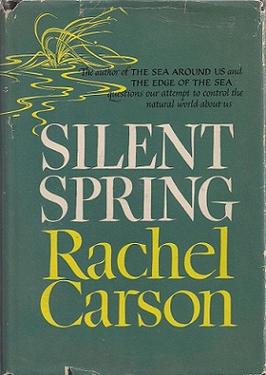You have 3 free guides left 😟
Unlock your guides8.13 The Environment and Natural Resources
3 min read•june 18, 2024
Robby May
Robby May
Environmental problems and economic concerns drove the United States to come up with a way to reliably produce energy.
Explain how and why policies related to the environment developed and changed from 1968 to 1980.
Environmental Activism
In 1962, activist wrote a book called . It is credited with launching the modern environmental movement. The book documented the detrimental effects of the widespread use of , particularly , on the environment and wildlife. It also argued that these chemicals were a threat to human health.

Image Courtesy of Wikipedia
The book's publication led to a significant public debate about the use of pesticides and their impact on the environment. As a result of the attention generated by the book, the US government banned the use of DDT in 1972 and established the to regulate the use of pesticides.
Silent Spring also led to a greater awareness of the interconnectedness of the environment and the importance of protecting it for the sake of both human and non-human species. It helped to change public perception of the environment and the role of government in protecting it, and it also led to a greater focus on the long-term effects of human actions on the environment.
Oil
Massive around the world, from off the coast of Santa Barbara, California in 1969 to the Exxon Valdez oil tanker accident in Alaska in 1989, reinforced fears about the deadly combination of human error and modern technology.
The of the 1960s-1980s also resulted in significant disruptions to the global oil market and had a major impact on the global economy.
The first oil crisis occurred in 1973 when a group of oil-producing countries, known as the Organization of the Petroleum Exporting Countries (OPEC), embargoed oil exports to countries that had supported Israel in the . This led to a sharp increase in oil prices and caused shortages in many countries.
As a result of the oil crises, Congress encated the 1975 . It set corporate standards for gas mileage. Manufacturers who failed to achieve the mandated averages faced stiff fines and other sanctions.
Environmentalists began searching for alternative sources of energy. appealed to some, but it was very expensive. Solar panels remained underdeveloped and intermittent clouds cut off power. was more reliable but most suitable for dam sites that had already been built upon. worked in some areas but those were places where few people lived.
Nuclear Power
had its advocates, as it had been in use since the 50s. Its fuel – – was virtually inexhaustible and it produced no noxious gases or greenhouse gases. It made many nervous. The waste products of the reactors were radioactive and would remain so for thousands of years.
Occasionally, nuclear reactors malfunctioned in a terrifying way. In March 1979, a reactor at Three Mile Island, near Harrisburg, PA nearly melted down when cooling systems failed. Tens of thousands of people in the area fled. While the reactors didn’t explode as authorities felt it might, it inspired grave thoughts about nuclear power.

Image Courtesy of Wikipedia
A more severe accident at Chornobyl in Soviet Ukraine in 1986 released large amounts of radiation into the atmosphere and caused many deaths, reinforcing fears.
Legislation
was first celebrated in April of 1970 and helped raise awareness about environmental problems. They followed the legislation in 1972 with the and the to combat industrial issues. In 1980, the was created to identify, investigate, and clean up the most complex, uncontrolled, or abandoned hazardous waste sites in the country.
© 2024 Fiveable Inc. All rights reserved.
AP® and SAT® are trademarks registered by the College Board, which is not affiliated with, and does not endorse this website.
